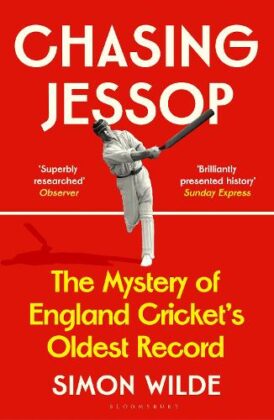Chasing Jessop
Martin Chandler |Published: 2025
Pages: 322
Author: Wilde, Simon
Publisher: Bloomsbury
Rating: 4 stars

Records are made to be broken is an old sporting mantra, and time and again we see the bar raised in all sports. Of course some records are in all probability unlikely to ever be broken, in cricketing terms Jim Laker’s being the most obvious. And then there are other records whose longevity suggests they might be unassailable, but which a bit of thought actually prompts some surprise that they still stand.
An example of the latter category is the fastest Test century by an Englishman. This is a record set as long ago as 1902 by Gilbert Jessop, and despite being surpassed by men from other nations on eleven occasions in the intervening 123 years, no Englishman has surpassed Jessop’s record of 76 balls. This is so despite the ultra aggressive approach to Test match batting introduced by England since 2022 following the appointment of Brendon McCullum as head coach, he being the man who, amongst all-comers, heads that particular list with his 54 ball effort in his final Test appearance, against Australia in 2016.
Jessop’s is a record I have always been aware of as, I suspect, have most cricket tragics but, unlike for Simon Wilde, it is not one that has ever greatly exercised my mind. Back in the Golden Age statistics were not kept as assiduously as they are today and, not unreasonably, it occurred to Wilde’s enquiring mind to try and check whether Jessop’s record stood up to closer examination, and the result of his research is Chasing Jessop, an examination of the life and times of Jessop and a detailed reconstruction of the dramatic match in which he set his record.
What Chasing Jessop is not is a biography. That much conceded there is inevitably something of the life story of the man involved, but only to the extent necessary to put the way the game was played in the Golden Age in its proper context. Jessop was an amateur, but not one who did not need to earn a living a position that, as it turns out, many amateurs were in. His captain in 1902, Archie MacLaren, was always short of income, and in much the same boat was CB Fry. Ranji’s financial issues are the stuff of legend. Stanley Jackson was in a much better position, although his availability was compromised because he had many demands on his time. The other amateur selected in the 1902 series was Lionel Palairet of Somerset, who opened the batting in the last two Tests. Outside cricket Palairet was a Land Agent who was pretty well off, and he seems not to have had too much difficulty in finding the time to play cricket.
Wilde’s book falls into three parts, the first containing Jessop’s background, that of the tour itself and accounts of the first four Tests in the series, two of which had been drawn and two of which had been won by Australia thus, by the time the teams reached the Oval, only English pride was at stake. Particularly interesting in Part One are a couple of subjects I had never really given a great deal of thought to before, those being the way in which the game was reported in the press in those days and, importantly in view of Wilde’s mission, the way it was recorded. He is a man of some tenacity is Wilde. Personally I would probably have given up as soon as I became aware that neither scorebook survived.
But Wilde carried on and Part Two of the book comprises a vivid account of the match which draws on a huge range of sources a number of which, with the widespread digitisation of old newspapers and magazines, have only become readily available in recent times. Wilde has also been able to draw on the efforts of others who have researched the match and whilst, surprisingly, there was no account of the series published in 1902 many, including a number of those involved, wrote about it subsequently.
The story of the match is exactly that, and in describing the events of 11, 12 and 13 August 1902 Wilde does not seek to count the deliveries faced. That exercise is reserved for Part Three and centres around two slightly different newspaper articles that appeared and which had clearly involved those responsible for them, and sadly their identities remain shrouded in mystery, adopting something along the lines of modern linear scoring methods and both purported to record the number of deliveries that Jessop faced.
Both articles are similar, but neither comes up with the long accepted figure of 76, so Wilde has had to reexamine both in the light of the multitude of other source material he has located. It is a little disappointing, albeit not at all surprising, that Wilde is unable to come up with a definitive answer to the question as to the number of deliveries Jessop faced on 13 August 1902. That said he is able to narrow it down to three possibilities, and 76 is not one of them.
So what is the answer? Having thought about it, and bearing in mind the subject matter of the book, while if I were to reveal it then I do not think I could really be accused of acting as spoiler, but having said that I don’t think I would have enjoyed the book as much as I did had I known in advance what Wilde’s conclusion would be, so I shall keep that one to myself.






Leave a comment